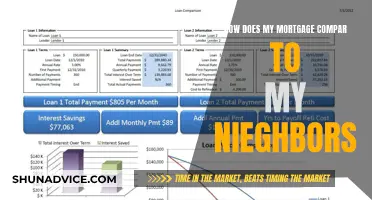
A mortgage modification is a change in the terms of a mortgage, allowing borrowers facing long-term financial hardship to reduce their monthly payments to an affordable level. The modification adjusts the mortgage agreement already in place with the current lender, and can involve a reduction in the interest rate, an extension of the payment term, or a reduction of the principal balance of the loan. This can help borrowers avoid missed payments and foreclosure.
| Characteristics | Values |
|---|---|
| Purpose | To help borrowers facing long-term financial hardship |
| Changes to the original mortgage | Extension of the loan period, reduction of interest rate, reduction of the principal balance of the loan |
| Requirements | Proof of significant financial hardship, imminent default, the loan must be at least one year old |
| Eligibility | Borrowers with a conventional loan owned by Fannie Mae or Freddie Mac |
| Consequences | Lower monthly payments, increased total amount paid over the life of the loan, negative impact on credit score |
What You'll Learn

Refinancing vs modification
Refinancing and modifying a mortgage are two different ways to change the original mortgage agreement. They share the same goal of lowering monthly payments but differ in their requirements and implications.
Refinancing
Refinancing involves securing a new mortgage with a new interest rate or loan term. It requires application, approval, and closing processes, along with associated costs. Refinancing may be a good option if you are current on your mortgage payments, can prove your income, and want to benefit from a lower interest rate or different loan terms. It can help you lower your monthly payments, pay off your home faster, or tap into home equity. However, it may also extend your repayment period, increasing the total amount paid over the life of the loan.
Modification
Loan modification, on the other hand, is a loss mitigation option for borrowers facing long-term financial hardship who are unable to make timely payments but want to stay in their homes. It changes the terms of the original mortgage agreement by adjusting the interest rate, loan term, or both, to make monthly payments more affordable. It does not require the same application, approval, and credit score requirements as refinancing, but it may come with a small administration fee. Modification may be a better option if you have less-than-perfect credit or a decreased income.
Key Differences
The main differences between refinancing and modification lie in the requirements and implications for the borrower. Refinancing requires applying for a new loan, which may not be an option for those facing financial difficulties. It can help lower monthly payments, especially with a lower interest rate, but it may also extend the repayment period, increasing the total cost of the loan. Modification, on the other hand, is designed for borrowers facing financial hardship and unable to make timely payments. It adjusts the current mortgage agreement to make payments more affordable, but it may also extend the loan term, resulting in higher interest costs over the life of the loan.
Rental Property Income: New Mortgage Game-Changer?
You may want to see also

Lower interest rates
Modifying a mortgage to lower interest rates can be a relief plan for homeowners who are facing difficulty in making their mortgage payments. This can be due to a long-term financial hardship, such as job loss, illness, or disability. A modification can help borrowers avoid foreclosure by either temporarily or permanently adjusting the loan's interest rate.
When modifying a mortgage to lower interest rates, the lender typically reduces the interest rate, which results in lower monthly mortgage payments and overall savings on interest. This can be done by switching from an adjustable-rate mortgage (ARM) to a fixed-rate mortgage, which provides more financial stability and protects borrowers from rising interest rates in the future. However, it's important to note that extending the repayment period may result in paying more interest over the life of the loan.
The modification process usually involves providing proof of hardship to the mortgage lender or servicer. If approved, the borrower will receive a lower interest rate, which can significantly reduce their monthly payments. It's important to carefully review the modification agreement, as the interest rate may be temporarily fixed for a certain period, after which it will adjust annually until it reaches the interest rate cap.
It's also worth noting that modification programs may have restrictions and fees associated with them, and they are not available for all loans. Borrowers with Fannie Mae or Freddie Mac-owned mortgages may be eligible for a Flex Modification, which allows lenders to reduce the interest rate or extend the loan term.
Overall, modifying a mortgage to lower interest rates can provide much-needed financial relief for homeowners facing long-term financial challenges. It helps make mortgage payments more manageable and affordable, allowing borrowers to stay in their homes and avoid foreclosure.
SunTrust Mortgage: Navigating Foreclosure and Your Options
You may want to see also

Fixed interest rates
A mortgage modification is a long-term financial relief option for borrowers facing financial hardship. It changes the terms of the original mortgage agreement to make payments more manageable and affordable. This can include extending the repayment length, reducing the interest rates, or both.
Fixed-rate mortgage loans typically have terms set for the life of the loan and cannot be changed without refinancing. However, if interest rates have dropped, you may be able to secure a lower fixed interest rate on your loan. Lowering the interest rate can significantly reduce your monthly payment. The rate decrease may be temporary or fixed, so it is important to check before agreeing to the modification.
Some homeowners have an initial fixed rate that switches to a variable interest rate a few years into their loan. Once their rate changes, their payments could fluctuate and end up costing them more than they can afford. The lender may be able to secure a fixed interest rate, making the payment amount more predictable and potentially less expensive.
If you have an adjustable-rate mortgage (ARM), refinancing with a fixed rate can provide consistent monthly payments. However, refinancing requires application, approval, and closing processes, along with associated costs. It may also extend your repayment period, which can increase the total amount paid over the life of the loan.
Lower Fees, Bigger Benefits: Refinancing Your Mortgage
You may want to see also

Long-term financial relief
A mortgage modification is a long-term financial relief option for homeowners who are unable to make their mortgage payments. It is designed for borrowers facing long-term financial hardship, such as a loss of income due to illness or other reasons, and can help them keep their homes.
The modification process involves changing the terms of the original mortgage agreement to make the payments more manageable. The lender will work with the borrower to find a way to lower the monthly payment by adjusting the terms of the current mortgage. This can include reducing the interest rate, extending the repayment period, or reducing the principal balance of the loan. For example, a 30-year mortgage may be extended to a 40-year mortgage, providing lower monthly payments but resulting in higher overall interest paid over the life of the loan.
Mortgage modification is different from refinancing, which involves securing a new mortgage with a new lender. Refinancing requires application, approval, and closing processes, along with associated costs. In contrast, mortgage modification adjusts the existing agreement with the current lender and may be a better option for those with imperfect credit or reduced income.
It is important to note that mortgage modification should be carefully considered, as it can have long-term implications for finances. Borrowers should understand how the modification will change their monthly payments and the total amount owed in the short and long term. Additionally, it is crucial to be aware that a modification may negatively impact one's credit score.
To qualify for a mortgage modification, borrowers typically need to provide proof of significant financial hardship and be approved by their lender. The goal of this relief option is to reduce monthly payments to an affordable level, helping borrowers stay up to date on their loans and retain their homes.
Exploring Mortgage Relief: Understanding 1031 Exchange Benefits
You may want to see also

Foreclosure prevention
A mortgage modification is a long-term financial relief option for borrowers facing long-term financial hardship. It changes the terms of the original mortgage agreement, helping borrowers to get back on track with their payments. The lender will work with the borrower to find a way to lower the monthly payment by adjusting the terms of the current mortgage.
The process of refinancing a mortgage involves securing a new mortgage, which requires application, approval, and closing processes, along with associated costs. On the other hand, a mortgage modification adjusts the mortgage agreement that is already in place with the current lender. This makes it a more viable option for borrowers with less-than-perfect credit or decreased income.
A mortgage modification can help a homeowner avoid foreclosure by reducing monthly payments and interest rates while lengthening the mortgage term. For example, a 30-year mortgage may change to a 40-year mortgage, giving the borrower a longer time to repay and lower payments each month. However, this also means that the borrower will pay more in interest over the life of the loan.
It is important to note that a mortgage modification may negatively impact a borrower's credit score. Additionally, borrowers should be cautious of foreclosure assistance or rescue companies that require upfront payment or tell them not to contact their mortgage company or an attorney.
Comparing Mortgages: How Does Yours Stack Up?
You may want to see also
Frequently asked questions
A mortgage modification is a process where the terms of a mortgage are changed outside the original terms of the contract agreed to by the lender and borrower.
A mortgage modification helps borrowers who are facing long-term financial hardship and are unable to make their mortgage payments. The goal of a mortgage modification is to reduce the borrower's monthly payments to an affordable level, helping them stay up to date on the loan and in their home.
A mortgage modification adjusts the mortgage agreement that's already in place with your current lender. The lender will work with the borrower to find a way to lower their monthly payment by adjusting the terms of their current mortgage.
Mortgage modifications can involve extending the number of years the borrower has to repay the loan, reducing the interest rate, and/or forbearing or reducing the principal balance.
While both refinancing and mortgage modification aim to lower the borrower's monthly payments, the two programs are very different. Refinancing requires application, approval, and closing processes, just like the original loan, along with the associated costs. It may also extend the repayment period, which can increase the total amount paid over the life of the loan. On the other hand, a mortgage modification adjusts the mortgage agreement that's already in place and does not require the same kind of application and approval as refinancing.







